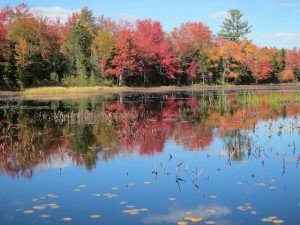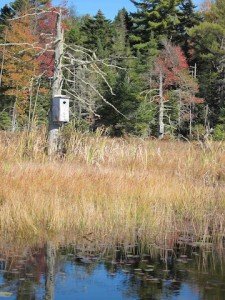
McDaniel’s Marsh Madness
McDaniel’s Marsh Madness
By Craig McArt and Renée Gustafson
 Beautiful as Eastman Lake is, are you tired of paddling the same-old-same-old? If so, maybe it’s time to venture outside of Eastman for a little variety; an interesting change of scene is just next-door at McDaniel’s Marsh. Paddling your kayak or canoe through a marsh may not sound that appealing, but this one could surprise you. McDaniel’s Marsh offers quiet water dotted with lilies, surrounded by pristine woodlands beautifully set against a background of scenic hills and mountains. Whether you are in an exercise mood or just want to paddle around and soak in the wonders of nature, the marsh has it all, and it’s just a very short drive south on Bog Road from Eastman.
Beautiful as Eastman Lake is, are you tired of paddling the same-old-same-old? If so, maybe it’s time to venture outside of Eastman for a little variety; an interesting change of scene is just next-door at McDaniel’s Marsh. Paddling your kayak or canoe through a marsh may not sound that appealing, but this one could surprise you. McDaniel’s Marsh offers quiet water dotted with lilies, surrounded by pristine woodlands beautifully set against a background of scenic hills and mountains. Whether you are in an exercise mood or just want to paddle around and soak in the wonders of nature, the marsh has it all, and it’s just a very short drive south on Bog Road from Eastman.
Although it has about the same area of surface water as Eastman Lake, you can’t cover all that area because much of it is too shallow. However, if you can manage to follow a deeper water channel, you’ll be able to reach the far end of this deceptively long marsh. The channel was probably the former Bog Brook streambed before it was dammed in 1958 and the 609-acre, five-mile long McDaniel’s Marsh Wildlife Management Area was created. The dam, by the intersection of Bog Road with George Hill Road at Washburn Corner, keeps the marsh at a fairly constant level, ideal for waterfowl nesting and feeding habitat.
The marsh was named after Charles McDaniel, a prominent descendant of James McDaniel, who established a large farm on nearby George Hill in the 1700s. Ownership by the New Hampshire Fish and Game Department protects nearly three-quarters of the marsh’s shoreline, while a 660-foot wetlands buffer extending beyond the wetland boundary affords additional protection. The parking area by the dam offers convenient access for launching boats and fishing.
 Starting out, watch for a group of submerged rocks a short distance off shore. Once past them, it’s clear going for quite a way before you begin maneuvering through shallow water dotted with lily pads along with a maze of sphagnum-laden hummocks and floating islands supporting a profusion of pitcher plants. Here’s where you’ll be looking to follow the deeper channel, which is the way to go if you can find it. In the distance will be the profile of Aaron’s Ledge. As you become familiar with the marsh, you will learn where the eagle tree is and where the great blue heron is apt to hunt. Drift and watch the swallows swoop overhead while dragonflies flit by.
Starting out, watch for a group of submerged rocks a short distance off shore. Once past them, it’s clear going for quite a way before you begin maneuvering through shallow water dotted with lily pads along with a maze of sphagnum-laden hummocks and floating islands supporting a profusion of pitcher plants. Here’s where you’ll be looking to follow the deeper channel, which is the way to go if you can find it. In the distance will be the profile of Aaron’s Ledge. As you become familiar with the marsh, you will learn where the eagle tree is and where the great blue heron is apt to hunt. Drift and watch the swallows swoop overhead while dragonflies flit by.
You’ll notice a beaver lodge or two as you paddle along. Other wildlife seen inhabiting McDaniel’s Marsh includes moose, otters, mink, turtles, mallards, loons and Canada geese. You’ll also notice nesting boxes that have been installed for wood ducks. These are strikingly beautiful ducks, the adult male with multicolored iridescent plumage and red eyes, the female with a white eye-ring and a whitish throat and both with crested heads. Unfortunately, they have a habit of “egg dumping,” which can happen if the nesting boxes are placed too close to each other. Females visit other wood duck nests, lay eggs in them and leave them to be raised by the other females.
The marsh has so much to offer: white water lilies, the rare white pickerel weed and, if you are agile, a place to climb ashore and enjoy a lunch. Paddling back, you’re certain to have a much better idea of where the best route with the deepest water is. When Croydon Mountain comes into view in the distance, you’ll have only a stretch of open water to cross on your way to the landing and your car. Before driving off, you may want to check out the impressive remains of William Washburn’s mill across the road. To do so, you will need to make your way several yards down the right bank of Bog Brook. Not far away is the beginning of an old road built in 1851 to connect the mill to Grantham, a road that was largely erased by the development of Eastman.
The best time to visit the marsh is in late September and early October when the trees, especially the red maples, are displaying their vibrant colors. By this time, the summer’s dense growth of waterweeds will have abated to make paddling easier, and pesky mosquitoes are gone. Give this destination a try and, hopefully, you’ll agree that “marsh madness” can also be “marsh gladness.”
Request More Information from:
Receive your complimentary Relocation guide and magazine


